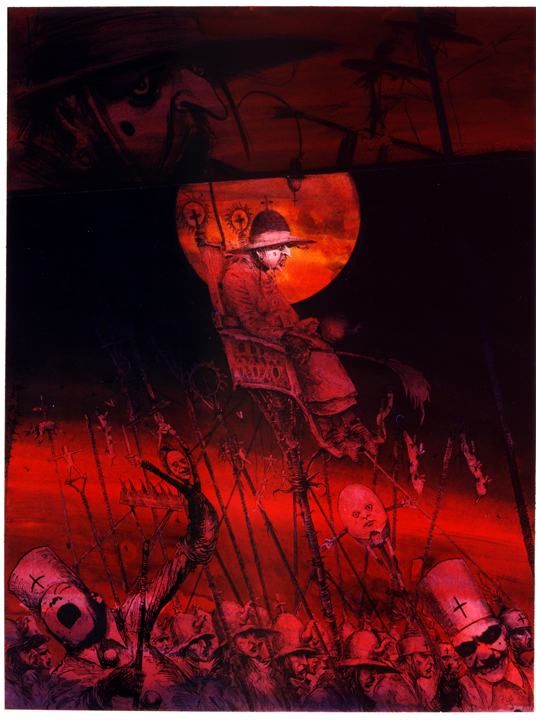A new collection of Ian Miller‘s art is out today. When I was in my early twenties, I was mildly obsessed by Miller’s graphic novel collaboration with M. John Harrison, The Luck in the Head, to the point that a few years ago, when I could finally afford to, I bought a couple of the originals, including the ‘Procession of the Mammy’ shown above (reproduction isn’t wonderful; it’s far sharper and not nearly as drenched with red in real life).
I thought about this graphic novel, and the Harrison short story it built on a lot last year, when Margaret Thatcher died. Neil Gaiman describes in his introduction to Harrison’s work how:
For me, the first experience of reading Viriconium Nights and In Viriconium was a revelation. I was a young man when I first encountered them, half a lifetime ago, and I remember the first experience of Harrison’s prose, as clear as mountain-water and as cold. The stories tangle in my head with the time that I first read them – the Thatcher Years in England seem already to be retreating into myth. They were larger-than-life times when we were living them, and there’s more than a tang of the London I remember informing the city in these tales, and something of the decaying brassiness of Thatcher herself in the rotting malevolence of Mammy Vooley (indeed, when Harrison retold the story of “The Luck in the Head” in graphic novel form, illustrated by Ian Miller, Mammy Vooley was explicitly drawn as an avatar of Margaret Thatcher).
He doesn’t mention (but then it’s an aside) how Harrison and Miller’s collaboration captures the contrast between Thatcher’s role as emblem and her frailty as a human being. In the picture, she’s already become a kind of ritual object, carted around to no particular purpose beyond display. Like the teapots that are the helmets of her supporters, she’s been superannuated and put to new uses that are both ludicrous and sinister. Another panel shows her after the procession, without her wig, shaven-headed, exhausted and empty, pushed along in a bath-chair by a lackey wearing a fish-head mask (a reference both to Miller’s art – he likes to draw fish – and to an incident in Harrison’s short novel _In Viriconium_). Miller and Harrison depict Thatcherism not as the revolution it believed itself to be, but as an aftermath where the symbols have been emptied of all meaning. Put another way, the senescent Thatcher depicted by Miller and Harrison’s Mammy Vooley represents less a foretelling of Thatcher’s own decline, than the decay of the movement that she represented (a decay which was already present in its moment of full flowering).

{ 6 comments }
Phil 04.16.14 at 12:02 am
a decay which was already present in its moment of full flowering
Well, was it? One key aspect of Thatcherism was the scandalous explicitness of Thatcher’s racism, imperialism and authoritarianism – the awful, forbidden voice she gave to longstanding and deep-rooted currents within Tory Britain. That was certainly something that couldn’t endure – part of its appeal was precisely that it couldn’t exist, and that it so plainly did. But all the while Thatcher played in the mythic register (on the taboo keys), she was also putting markers down in the grubby world of the politically real. And those markers – the role of the state, the role of profit – have endured; more to the point, they’ve proved so enduring (I believe) precisely because of the mythic force of scandalous Thatcherism.
Pardon the baroque diction, I’m rather drunk.
NickT 04.16.14 at 3:43 am
Ian Miller did some lovely covers for Michael Scott Rohan’s Winter of the World series – a series which deserves more attention than it generally gets among fantasy fans.
Maria 04.16.14 at 8:17 am
What a wonderfully Benjamin-esque sentence: “the senescent Thatcher depicted by Miller and Harrison’s Mammy Vooley represents less a foretelling of Thatcher’s own decline, than the decay of the movement that she represented (a decay which was already present in its moment of full flowering).”
ian miller 04.16.14 at 8:40 am
Thank you for the attention and mention. I’ll send it on to John. I’m sure he will also appreciate this article. As a point of interest, there are suggestions of republishing this title, but it is early days yet.
Best regards and thanks
Ian
Metatone 04.17.14 at 8:32 am
To carry on from Phil’s thoughts…
We’ve had various descendants of Thatcher, but at this moment in time, these come most to my mind:
Tony Blair – the New Labour acceptance of “Thatcherite Economics”
Ian Duncan Smith – this is where you end up when ideology trumps evidence?
Nigel Farage, UKIP and then further along the spectrum, the EDL.
Thatcher’s grip on power was cemented by bringing these people inside the Tory tent. Now they’ve staggered out again, as much because of broader cultural/political trends (Coalition, etc.) as anything.
We were often told, growing up, that Thatcher bringing them in the tent prevented the rise of a “Le Pen style National Front party” – yet you can’t help wonder if the opposite is true. The “First Past the Post” system meant a British Le Pen was never going anywhere electorally – culturally did Thatcher’s Tory party incubate and legitimate UKIP (certainly) and the EDL (much less clear…)
Metatone 04.17.14 at 8:34 am
I forgot to add – the ultimate oddity of Thatcher is that while she was in various measures “Thatcherite” you wonder if she was as subservient to global capital and The City as David Cameron… there’s a sneaking feeling that at least she would have rejected their usurpation of her own power, if nothing else…
Comments on this entry are closed.